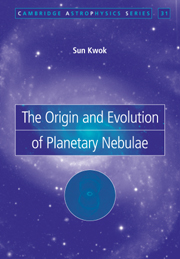Book contents
- Frontmatter
- Contents
- Preface
- 1 History and overview
- 2 Ionization structure of planetary nebulae
- 3 Nebular line radiation
- 4 Nebular continuum radiation
- 5 The neutral gas component
- 6 The dust component
- 7 Observations of the central star of planetary nebulae
- 8 Morphologies of planetary nebulae
- 9 Problems and questions
- 10 Asymptotic giant branch stars – progenitors of planetary nebulae
- 11 Evolution of the central stars
- 12 Formation of planetary nebulae
- 13 Dynamical evolution of planetary nebulae
- 14 Protoplanetary nebulae – the transition objects
- 15 Evolution to the white dwarf stage
- 16 Distances to planetary nebulae
- 17 Comparison between evolutionary models and observations
- 18 PN in the galactic context
- 19 Chemical abundances
- 20 Planetary nebulae in other galaxies
- 21 Concluding remarks
- References
- Appendix List of symbols and abbreviations
- Subject index
18 - PN in the galactic context
Published online by Cambridge University Press: 04 November 2009
- Frontmatter
- Contents
- Preface
- 1 History and overview
- 2 Ionization structure of planetary nebulae
- 3 Nebular line radiation
- 4 Nebular continuum radiation
- 5 The neutral gas component
- 6 The dust component
- 7 Observations of the central star of planetary nebulae
- 8 Morphologies of planetary nebulae
- 9 Problems and questions
- 10 Asymptotic giant branch stars – progenitors of planetary nebulae
- 11 Evolution of the central stars
- 12 Formation of planetary nebulae
- 13 Dynamical evolution of planetary nebulae
- 14 Protoplanetary nebulae – the transition objects
- 15 Evolution to the white dwarf stage
- 16 Distances to planetary nebulae
- 17 Comparison between evolutionary models and observations
- 18 PN in the galactic context
- 19 Chemical abundances
- 20 Planetary nebulae in other galaxies
- 21 Concluding remarks
- References
- Appendix List of symbols and abbreviations
- Subject index
Summary
In the earlier chapters, we discussed the radiative and mechanical processes in PN. These processes all contribute toward the interstellar radiation field and the return of stellarprocessed material to the interstellar medium. The return of mass to the interstellar medium is not only important in providing material for the formation of next generation of stars, but also in seeding the interstellar medium with CNO products that provide the cooling agents necessary for the collapse of interstellar clouds and star formation. In order for the relative importance between PN and other contributors (e.g. Wolf-Rayet stars and supernovae) to be assessed, it is necessary to know the total PN population in the Galaxy.
The first estimate of the total population of PN in the Galaxy (6 × 104) was given by Shklovsky (1956b), using the distance scale that he developed. This determination is instrumental in establishing the evolutionary status of PN as a stage that is passed through by all low-mass stars (Abell and Goldreich, 1966). This number also gives us an insight into the star-formation history of the Galaxy, as the progenitor stars of the PN that we are observing today were born billions of years ago.
Formation rate of PN in the Galaxy
In principle, the derivation of the formation rate of PN (x) is straightforward once the local number density of PN is known.
Information
- Type
- Chapter
- Information
- The Origin and Evolution of Planetary Nebulae , pp. 190 - 198Publisher: Cambridge University PressPrint publication year: 2000
